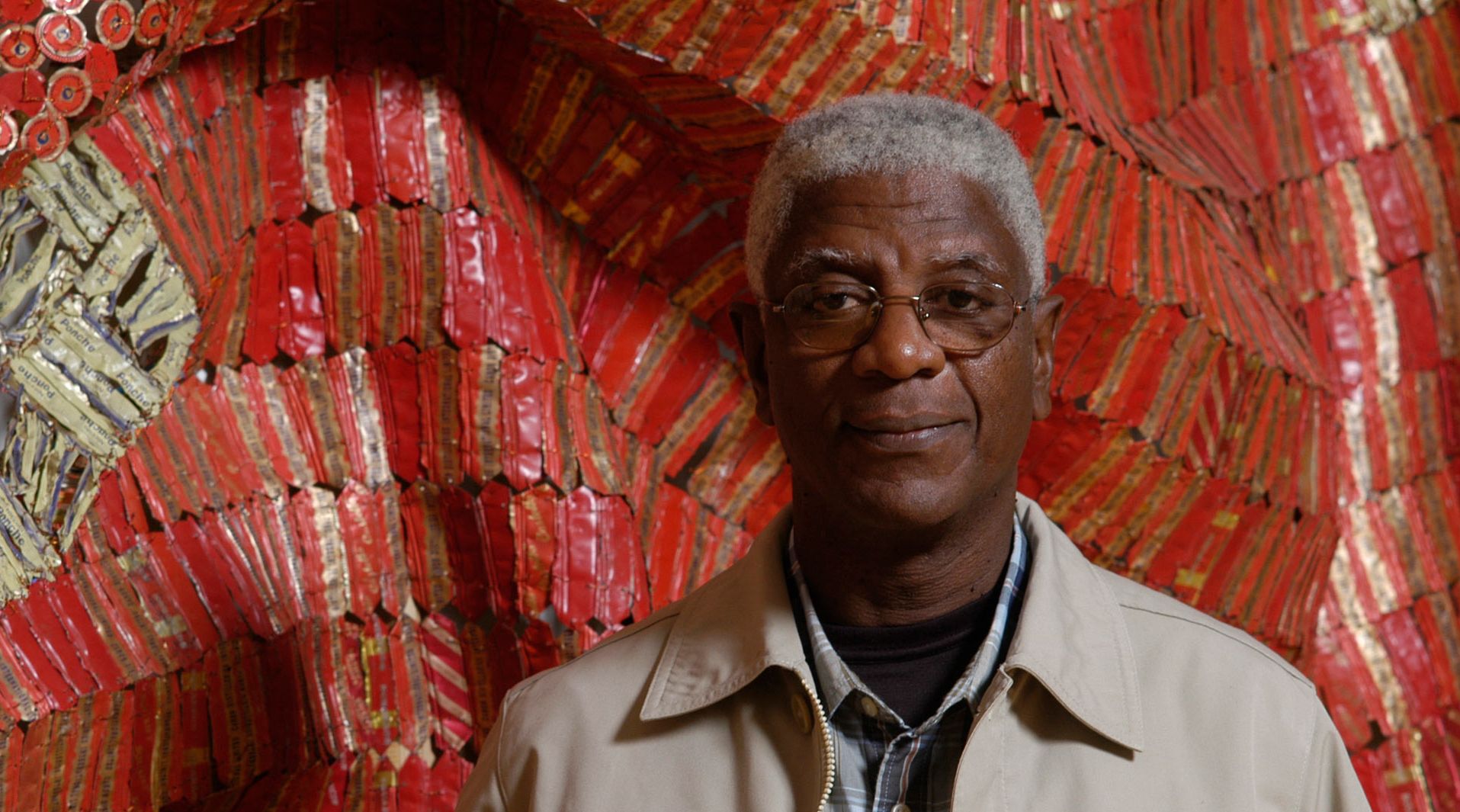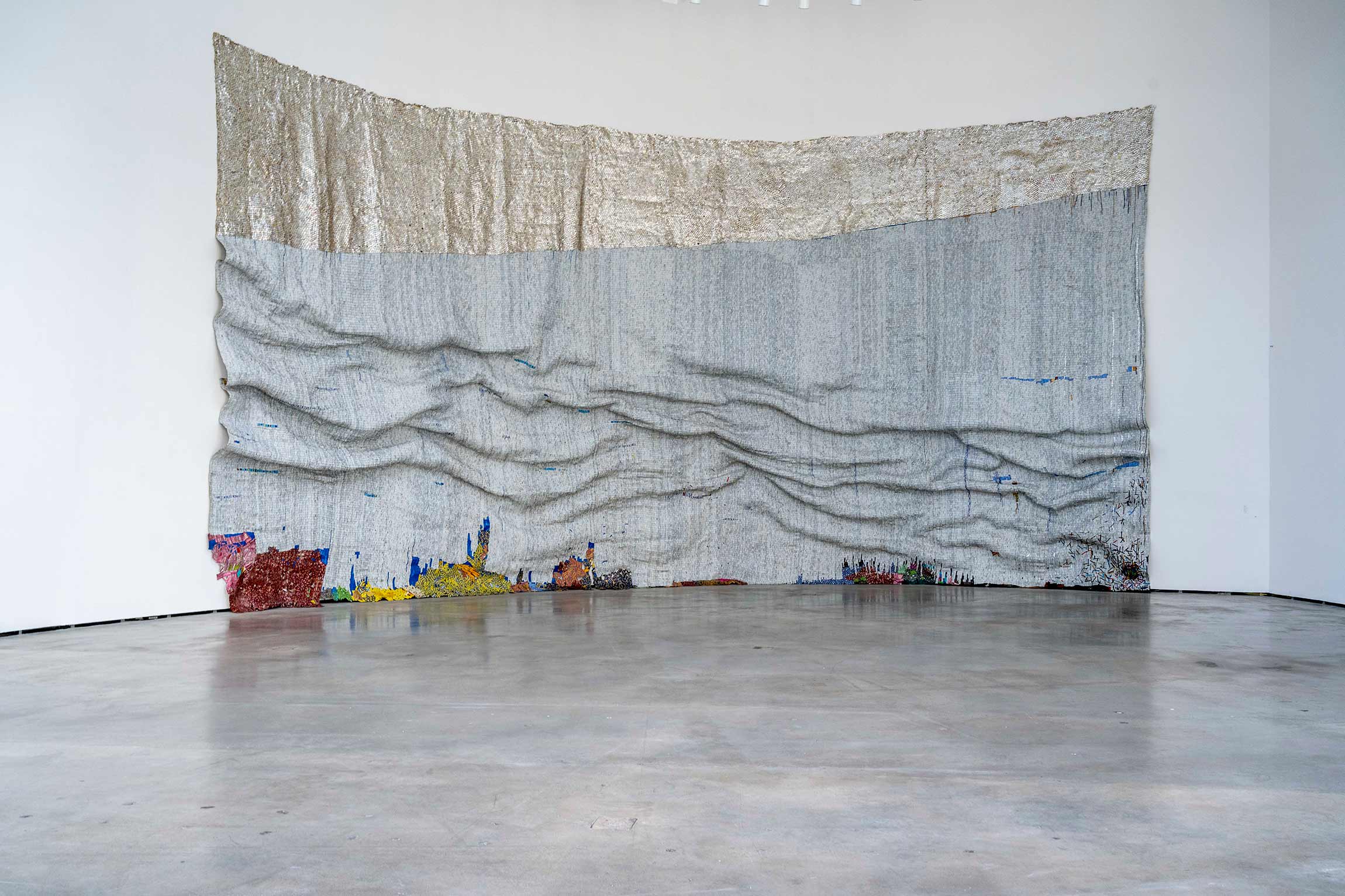El Anatsui. Courtesy of the artist, October Gallery, London, and Jack Shainman Gallery, New York.
Anatsui, El
Anyako, Ghana, 1944

19
44
Born on 4 February in Anyako, Ghana
69
Completed his postgraduate diploma in Arts Education with Honorary Mention at the Kumasi University of Science and Technology, Ghana.
75
After six years teaching at the university where he graduated in Ghana, he joined the Fine and Applied Arts Department at the University of Nigeria, Nsukka, where he has held various teaching positions until now.
First solo exhibition in Nsukka, at the Acele Art Gallery, entitled Wooden Wall Plaques.
90
First group exhibition in New York, at the Studio Museum in Harlem; he was also one of three artists whose work was exhibited at the Contemporary African Artist: Changing Tradition exhibition, which was so successful it ran for five years. Also in 1990, he participated in the Venice Biennale in a group exhibition with other African artists; the show was awarded with an Honorary Mention, elevating El Anatsui to a new level of international recognition.
91
First major solo exhibition at the National Museum of Lagos, Nigeria, entitled Old and New: An Exhibition of Sculpture in Assorted Wood by El Anatsui.
92
Developed the wood-based sculpture entitled Erosion at a workshop of international artists in Brazil, coinciding with the International Earth Summit held in Rio de Janeiro. This boosted his career visibility and strengthened his position as an acclaimed artist of recycled art. Erosion became part of the African Art collection at the Smithsonian National Museum, USA.
95
First solo exhibition outside Africa, at the October Gallery in London, UK.
98
Participated in the 9th Sculpture Triennale in Osaka, Japan, where he won the bronze award.
99
A crucial year for El Anatsui, as he found a bag full of metal seals and African liquor bottle caps, marking the start of a crucial material and aesthetic journey in the development of his artistic language. This new vocabulary gave rise to colossal installations made with crushed bottle tops and necks, cut-out and strung together with copper wire.
02
He exhibited his new sculptures Man’s Cloth and Woman’s Cloth at the October Gallery in London. They were the first where liquor bottle caps instead of wood were used. In his sculptures, the artist pursued the themes of memory and loss, especially the damage caused during the colonial period and the traumatic post-colonial scars left behind. He used the concept of “fabric” as a metaphor, both of fragility and of the dynamism and strength of tradition. El Anatsui worked on these two sculptures simultaneously, developing their subtle differences.
05
Exhibition at the Skoto Gallery in New York, Danudo, the first presentation of his metal pieces in an American city. This exhibition popularized his works with bottle caps, as the artist progressively gained greater recognition in the press.
07
El Anatsui began to test the physical limits of his work through the series Bleeding Takari and Bleeding Takari II, both 2007, the latter of which is now in the Museum of Modern Art, New York. In this series, the artist began to develop a change of language, which evolved from the strip compositions of his earliest pieces that function almost like a tapestry, allowing his work to enter a more sculptural arena. That year he participated once again in the Venice Biennale.
08
He personally installed his hanging sculpture Between Earth and Heaven, 2006, in the Metropolitan Museum, New York, the first large-scale work of contemporary African sculpture acquired by the institution.
09
With Ink Spill, he embarked on an experimental series that produced spectacular and iconic pieces such as Ink Splash II, part of the Tate Modern collection. The works in the Ink series testify to El Anatsui’s interest in pure abstraction, not necessarily mediated by ethnographic references to his culture of origin.
10
Retrospective of his work at the Royal Ontario Museum in Toronto, Canada, entitled When I Last Wrote to You about Africa, which traveled around various museums in the US for three years. The exhibition included both large-format metal sculptures and earlier works including ceramic and wooden pieces. It showcased the evolution of El Anatsui’s artistic practice over four decades, reflecting his concerns about social and cultural issues, along with historical identity.
13
Major exhibition of recent work by El Anatsui at the Brooklyn Museum in New York entitled Gravity & Grace: Monumental Works by El Anatsui. Originally organized by the Akron Art Museum in 2012, it then traveled to the Des Moines Art Center (2013–14) and the Bass Museum of Art in Miami (2014).
15
The Venice Biennale awarded El Anatsui the Golden Lion for his artistic career.
16
He received an Honorary Doctorate from the Kwame Nkrumah University of Science and Technology (Kumasi, Ghana).
17
He received an Honorary Doctorate from Harvard University and was awarded the Praemium Imperiale, making him the first Ghanaian artist to receive this award.
19
The Haus der Kunst in Munich inaugurated the exhibition entitled Triumphant Scale, which looked back over his entire career and was organized by Okwui Enwezor and Chika Okeke-Agulu. The show attracted a record number of visitors. Triumphant Scale later went to the Arab Museum of Modern Art in Doha (Qatar) and the Kunstmuseum Bern (Switzerland) in 2020.
22
El Anatsui: Day After Night opens at Barakat Contemporary in Seoul, South Korea.
Shows works at The Arts Club in Dubai, Goodman Gallery in Cape Town, and Efie Gallery in Dubai.
Participates in Sections/Intersections. 25 Years of the Guggenheim Museum Bilbao Collection, an exhibition of works from the Museum Collection staged to celebrate the Museum’s 25th anniversary. Perspectivas, the 25th-anniversary documentary produced by the Guggenheim Museum Bilbao and La Caixa Foundation, includes a section about El Anatsui.
23
Makes Behind the Red Moon, a monumental sculptural installation for Tate Modern’s Turbine Hall.
TimeSpace solo exhibition opens at October Gallery in London.
Is featured on the Time Magazine list of the 100 Most Influential People.
Participates in Chaleur Humaine: Triennale Art & Industrie, a large-scale group exhibition held in Dunkerque, France; in Collection Highlights at the Rubell Museum in Miami; and in Accra! The Rise of a Global Art Community, an exhibition showcasing the work of eighteen artists with deep connections to Accra, Ghana, including Lynette Yiadom-Boakye, among others.
24
Shows his work in Music, Fluidity and Reinvention: El Anatsui’s Record Collection at Efie Gallery, Dubai.
Takes part in the Diriyah Contemporary Art Biennale in Saudi Arabia.

